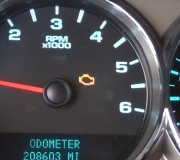What are you trying to solve by removing the catalytic converters? The exhaust gas is constantly switching between too rich and too lean, about two times per second, and the Engine Computer watches the readings from the front oxygen sensors to maintain the perfect average fuel/air mixture. The readings from those front oxygen sensors are part of the fuel metering calculations the computer looks at to know how much fuel to inject.
Engine performance is not affected by the operation of the catalytic converters, however, the computer does watch that the converters are doing their job on all 1996 and newer models. It sees that by the readings from the rear oxygen sensors, (those that come right behind the catalytic converters). When the converters are working properly, excess oxygen from the lean part of the cycle is stored in the catalyst, then it is combined with the excess gas during the rich part of the cycle, and is burned. What you see leaving the converter will switch between slightly rich and slightly lean very slowly, perhaps once every minute or two, . . . as long as the converter is present and working.
As the catalyst becomes contaminated or ineffective, and it stops cleaning up the exhaust gas, less and less change takes place in that gas as it passes through the converter. The switching rate for the rear oxygen sensors speeds up until when no change is taking place, the switching rate will exactly equal that of the front sensors, because they are both seeing the same gas composition. At some point along the way the computer realizes the converter isn't doing anything. It sets a related diagnostic fault code, and any fault code related to something that could adversely affect emissions will turn on the Check Engine light.
The computer also runs a lot of tests at various times. For some of them, it expects to see the results of those tests show up as specific changes in the oxygen sensor readings. Once a fault code is set related to "catalytic converter efficiency", the computer knows it can't run any tests that need the oxygen sensor readings to see the results or make comparisons. Those tests will be suspended until the cause of that fault code is repaired. Where this becomes a miserable problem is when a second, different problem develops, especially one that affects engine performance, tests to detect the cause of that problem won't run, and no fault code will be set. With no fault code to go on, your mechanic will not have any idea where to start the diagnosis.
Also related to that potential second problem, particularly if it does not seriously affect engine performance, is you will never know when it occurred because the check engine light is already on. Your computer can detect well over 2,000 defects. Many of them have very minor causes, but if ignored unwittingly, can turn into real expensive repairs. Some tests will not run, and with those that do, if a problem develops, you will not know it. The only solution is to put the catalytic converters back on. The have such little restriction that they do not detract from engine performance. The only thing they do really well is clean up the exhaust so effectively that you can suck on the tail pipe and live to tell about it.
Also, be aware you can create a new running problem if there is a leak in the exhaust pipe next to or ahead of the front oxygen sensors. Between the pulses of exhaust gas flow, there is slight pulses of vacuum created by the flow's momentum. Those pulses of vacuum can suck in outside air through a leak, then the oxygen in that air gets falsely detected as a too-lean condition. The computer will respond by increasing the amount of fuel, but no matter how much it adds, there will always be that extra oxygen being detected. Typically the computer can only adjust the fuel/air mixture plus or minus about ten percent, but that is more than enough to result in terrible fuel mileage. Excess gas can wash the oil off the cylinder walls resulting in scuffing, and the increased blow by results in sludge in the oil. Both of those can shorten the life of the engine.
You might find some more information in this article:
https://www.2carpros.com/articles/how-emission-control-systems-work
Sunday, August 12th, 2018 AT 9:31 PM


